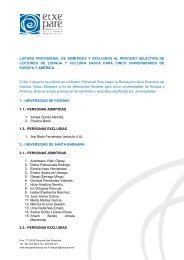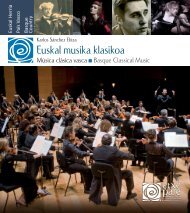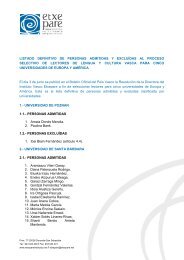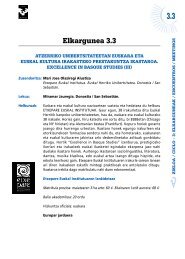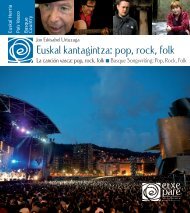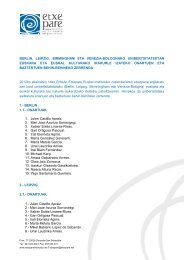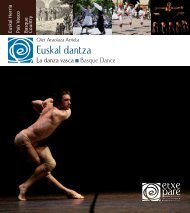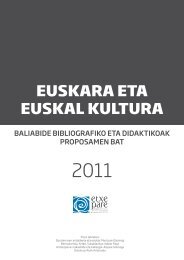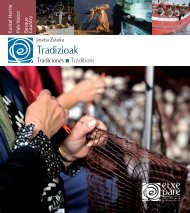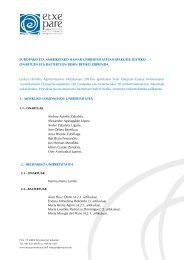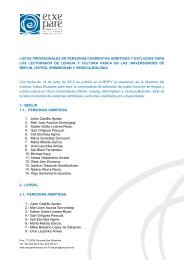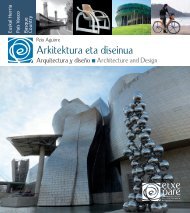XX. mendeko euskal literatura - Etxepare, Euskal Institutua
XX. mendeko euskal literatura - Etxepare, Euskal Institutua
XX. mendeko euskal literatura - Etxepare, Euskal Institutua
Create successful ePaper yourself
Turn your PDF publications into a flip-book with our unique Google optimized e-Paper software.
Aresti vivió de cerca las desastrosas consecuencias<br />
de la industrialización en 1958, la pobreza y explotación<br />
de los trabajadores. Ello junto a la lectura de<br />
la obra de Gabriel Celaya y Blas de Otero lo empujó<br />
a escribir poesía de protesta. Poco después salió a la<br />
calle el fruto de dicho planteamiento: el poemario<br />
Harri eta Herri (1964). En sus siguientes obras, <strong>Euskal</strong><br />
harria (1967) y Harrizko herri hau (1970), el poeta<br />
optó por el mismo camino.<br />
Aresti y su obra tuvieron una gran influencia tanto<br />
en la creación literaria como en la valoración crítica<br />
e ideológica de la <strong>literatura</strong> en euskera del momento.<br />
Bitoriano Gandiaga (Mendata, 1928 - Arantzazu,<br />
2001) y Juan Mari Lekuona (Oiartzun, 1927 - San<br />
Sebastián, 2005) desarrollaron su poética simbolista<br />
bajo la influencia de la poesía social. Sin embargo,<br />
pese a partir de la misma base, la poética de estos<br />
dos poetas tuvo un desarrollo distinto; en los últimos<br />
años de su carrera Gandiaga retornó a la poesía litúrgica<br />
y tradicional mientras que Lekuona giró hacia el<br />
surrealismo. En el primer poemario de Xabier Lete<br />
(Oiartzun, 1944-2010), Egunetik egunera orduen<br />
gurpillean (1968), la fusión entre las raíces arestianas<br />
y los planteamientos tradicionales es clara. En verdad,<br />
la influencia de la <strong>literatura</strong> oral y, sobre todo,<br />
del bertsolarismo es notable en toda su obra. A partir<br />
del poemario Bigarren poema liburua (1974), Lete<br />
giró hacia el existencialismo, creando poemas mucho<br />
más íntimos. Posteriormente publicó los poemarios<br />
Urrats desbideratuak (1981), Zentzu antzaldatuen<br />
poemategia (1992) y Egunsentiaren esku izoztuak<br />
(2008), este último galardonado con el premio Euskadi<br />
de Literatura.<br />
La década de 1970 fue una época de gran control<br />
ideológico para los creadores vascos, ya que se vieron<br />
sometidos a la disciplina del compromiso social.<br />
En 1975, a través de varias publicaciones colectivas,<br />
se dieron los primeros pasos hacia la libertad creativa<br />
en el ámbito literario. La Pott Banda de Bilbao,<br />
la cual combinó la perspectiva poética de Aresti y la<br />
experienced first-hand the disastrous consequences<br />
of industrialisation, poverty and the exploitation of<br />
workers, in the late 1950s. This experience, added to<br />
his reading of Gabriel Celaya and Blas de Otero, led<br />
him to write protest poetry. Shortly afterwards, he<br />
published the result of this: Harri eta Herri (1964). He<br />
opted for the same direction too in his later works:<br />
<strong>Euskal</strong> harria (1967) and Harrizko herri hau (1970).<br />
Aresti was very influential in both literary creativity<br />
and the critical and ideological evaluation of literature<br />
in Euskara at that time. Bitoriano Gandiaga<br />
(Mendata, 1928 - Arantzazu, 2001) and Juan Mari<br />
Lekuona (Oiartzun, 1927 - Donostia-San Sebastián,<br />
2005) were influenced by social poetry in their own<br />
symbolist poetry. Yet in spite of the fact that they<br />
shared similar roots, their poetic style was quite<br />
different. In the final years of his career, Gandiaga<br />
returned to traditional liturgical poetry while Lekuona<br />
moved towards surrealism. In the first book of<br />
poems by Xabier Lete (Oiartzun, 1944-2010), Egunetik<br />
egunera orduen gurpillean (1968), there is a clear<br />
blend of Arestian roots and traditional approaches of<br />
the era. In truth, the influence of oral literature and<br />
especially bertsolaritza pervades Lete’s whole work.<br />
With the publication of his second book of poems,<br />
Bigarren poema liburua (1974), Lete turned towards<br />
existentialism, creating more intimate poems. His<br />
later publications included Urrats desbideratuak<br />
(1981), Zentzu antzaldatuen poemategia (1992) and<br />
Egunsentiaren esku izoztuak (2008), the latter being<br />
awarded the Euskadi Prize for Literature.<br />
The 1970s was an era of major ideological control<br />
for Basque artists, given that they had to yield to<br />
the discipline of social commitment. In 1975, several<br />
collective publications took the first steps towards<br />
creative freedom in the literary sphere. The group<br />
Pott Banda in Bilbao, which combined Aresti’s poetic<br />
perspective with those of the principal European<br />
avant-garde movements, played a decisive role in<br />
this period. Etiopia (1978) by Bernardo Atxaga (As-<br />
57



